A Wide-Angle and Polarization-Insensitive Rectifying Metasurface for 5.8 GHz RF Energy Harvesting
Abstract
1. Introduction
2. Rectifying Metasurface Design and Analysis
3. Rectifying Metasurface Measurements and Discussion
4. Conclusions
Author Contributions
Funding
Data Availability Statement
Conflicts of Interest
References
- Sudevalayam, S.; Kulkarni, P. Energy harvesting sensor nodes: Survey and implications. IEEE Commun. Surv. Tutor. 2010, 13, 443–461. [Google Scholar] [CrossRef]
- Zhao, Y.; An, W.; Luo, Y.; Li, S.; Xiong, L.; Yu, S. Low-profile antenna integrated with solar cells for the 2.4 GHz band. IEEE Antennas Wirel. Propag. Lett. 2021, 20, 443–447. [Google Scholar] [CrossRef]
- Kim, J.H.; Kim, B.; Kim, S.W.; Kang, H.W.; Park, M.C.; Park, D.H.; Ju, B.K.; Choi, W.K. High-performance coaxial piezoelectric energy generator (C-PEG) yarn of Cu/PVDF-TrFE/PDMS/Nylon/Ag. Nanotechnology 2021, 32, 145401. [Google Scholar] [CrossRef] [PubMed]
- Gharapetian, D.; Fini, M.A.; Asgari, M.; Shabani, B. A nanofluid-based hybrid photovoltaic-thermal-thermoelectric generator system for combined heat and power applications. Energy Convers. Manag. 2024, 301, 118066. [Google Scholar] [CrossRef]
- Gharapetian, D.; Fini, M.A.; Bazargan, M. An exergy-economic analysis of a concentrated photovoltaic-thermal system with phase change materials cooled by a nanofluid in porous media. J. Energy Storage 2023, 72, 108336. [Google Scholar] [CrossRef]
- Dong, L.; Hu, G.; Tang, Q.; Zhao, C.; Yang, F.; Yang, Y. Advanced aerodynamics-driven energy harvesting leveraging galloping-flutter synergy. Adv. Funct. Mater. 2025, 35, 2414324. [Google Scholar] [CrossRef]
- Dong, L.; Ke, Y.; Liao, Y.; Wang, J.; Gao, M.; Yang, Y.; Li, J.; Yang, F. Rational modeling and design of piezoelectric biomolecular thin films toward enhanced energy harvesting and sensing. Adv. Funct. Mater. 2024, 34, 2410566. [Google Scholar] [CrossRef]
- Lin, K.T.; Lin, H.; Yang, T.; Jia, B. Structured graphene metamaterial selective absorbers for high efficiency and omnidirectional solar thermal energy conversion. Nat. Commun. 2020, 11, 1389. [Google Scholar] [CrossRef]
- Sreelekshmi, S.; Sankar, S.P. A square ring and single split resonator based wearable antenna for microwave energy harvesting for IoT nodes. Sustain. Energy Technol. Assess. 2022, 52, 102217. [Google Scholar] [CrossRef]
- Wu, X.; Xue, H.; Zhao, S.; Han, J.; Chang, M.; Liu, H.; Li, L. Accurate and efficient method for analyzing the transfer efficiency of metasurface-based wireless power transfer system. IEEE Trans. Antennas Propag. 2022, 71, 783–795. [Google Scholar] [CrossRef]
- Sun, H.; He, H.; Huang, J. Polarization-insensitive rectenna arrays with different power combining strategies. IEEE Antennas Wirel. Propag. Lett. 2020, 19, 492–496. [Google Scholar] [CrossRef]
- Zhang, P.; Zhang, X.; Li, L. An optically transparent metantenna for RF wireless energy harvesting. IEEE Trans. Antennas Propag. 2021, 70, 2550–2560. [Google Scholar] [CrossRef]
- Guo, J.; Zhang, H.; Zhu, X. Theoretical analysis of RF-DC conversion efficiency for class-F rectifiers. IEEE Trans. Microw. Theory Tech. 2014, 62, 977–985. [Google Scholar] [CrossRef]
- Ding, W.; Chen, J.; Wu, R.X. A generative meta-atom model for metasurface-based absorber designs. Adv. Opt. Mater. 2023, 11, 2201959. [Google Scholar] [CrossRef]
- Han, Y.; Che, W.; Christopoulos, C.; Xiong, Y.; Chang, Y. A fast and efficient design method for circuit analog absorbers consisting of resistive square-loop arrays. IEEE Trans. Electromagn. Compat. 2016, 58, 747–757. [Google Scholar] [CrossRef]
- Kundu, D.; Mohan, A.; Chakrabarty, A. Single-layer wideband microwave absorber using array of crossed dipoles. IEEE Antennas Wirel. Propag. Lett. 2016, 15, 1589–1592. [Google Scholar] [CrossRef]
- Fu, C.; Han, L.; Liu, C.; Lu, X.; Sun, Z. Combining Pancharatnam–Berry phase and conformal coding metasurface for dual-band RCS reduction. IEEE Trans. Antennas Propag. 2021, 70, 2352–2357. [Google Scholar] [CrossRef]
- Ha, T.D.; Zhu, L.; Alsaab, N.; Chen, P.Y.; Guo, J.L. Optically transparent metasurface radome for RCS reduction and gain enhancement of multifunctional antennas. IEEE Trans. Antennas Propag. 2022, 71, 67–77. [Google Scholar] [CrossRef]
- Abdullah, M.; Koziel, S. Supervised-learning-based development of multibit RCS-reduced coding metasurfaces. IEEE Trans. Microw. Theory Tech. 2021, 70, 264–274. [Google Scholar] [CrossRef]
- Landy, N.I.; Sajuyigbe, S.; Mock, J.J.; Smith, D.R.; Padilla, W.J. Perfect metamaterial absorber. Phys. Rev. Lett. 2008, 100, 207402. [Google Scholar] [CrossRef]
- Bhardwaj, A.; Singh, G.; Srivastava, K.V.; Ramkumar, J.; Ramakrishna, S.A. Polarization-insensitive optically transparent microwave metamaterial absorber using a complementary layer. IEEE Antennas Wirel. Propag. Lett. 2021, 21, 163–167. [Google Scholar] [CrossRef]
- Chen, Y.; Chen, K.; Zhang, D.; Li, S.; Xu, Y.; Wang, X.; Zhuang, S. Ultrabroadband microwave absorber based on 3D water microchannels. Photonics Res. 2021, 9, 1391–1396. [Google Scholar] [CrossRef]
- Aydin, K.; Ferry, V.E.; Briggs, R.M.; Atwater, H.A. Broadband polarization-independent resonant light absorption using ultrathin plasmonic super absorbers. Nat. Commun. 2011, 2, 517. [Google Scholar] [CrossRef] [PubMed]
- Munk, B.A.; Munk, P.; Pryor, J. On designing Jaumann and circuit analog absorbers (CA absorbers) for oblique angle of incidence. IEEE Trans. Antennas Propag. 2007, 55, 186–193. [Google Scholar] [CrossRef]
- Li, S.; Gao, J.; Cao, X.; Li, W.; Zhang, Z.; Zhang, D. Wideband, thin, and polarization-insensitive perfect absorber based on the double octagonal rings metamaterials and lumped resistances. J. Appl. Phys. 2014, 116, 042002. [Google Scholar] [CrossRef]
- Wang, X.; Han, J.Q.; Li, G.X.; Xia, D.X.; Chang, M.Y.; Ma, X.J.; Xue, H.; Xu, P.; Li, R.J.; Zhang, K.Y.; et al. High-performance cost-efficient simultaneous wireless information and power transfers deploying jointly modulated amplifying programmable metasurface. Nat. Commun. 2023, 14, 6002. [Google Scholar] [CrossRef] [PubMed]
- Vinnakota, S.S.; Kumari, R.; Majumder, B. Metasurface-assisted broadband compact dual-polarized dipole antenna for RF energy harvesting. IEEE Antennas Wirel. Propag. Lett. 2023, 22, 1912–1916. [Google Scholar] [CrossRef]
- Dong, L.; Si, L.; Liu, B.; Shen, Q.; Niu, R.; Bao, X.; Sun, H.; Zhu, W. An optically transparent rectifying metasurface for 2.4/5.8 GHz dual-band RF energy harvesting. Appl. Phys. Lett. 2025, 126, 012345. [Google Scholar] [CrossRef]
- Gui, H.; Xie, H.; Deng, L.; Huang, S.; Qiu, L.-L. Triple-band and polarization-insensitive rectifying metasurface with flexible substrate. J. Phys. D Appl. Phys. 2024, 57, 165003. [Google Scholar] [CrossRef]
- Amer, A.A.G.; Othman, N.; Sapuan, S.Z.; Alphones, A.; Hassan, M.F.; Al-Gburi, A.J.A.; Zakaria, Z. Dual-band, wide-angle, and high-capture efficiency metasurface for electromagnetic energy harvesting. Nanomaterials 2023, 13, 2015. [Google Scholar] [CrossRef]
- Eskandari, M.; Habibzadeh-Sharif, A.; Nazari, M. Design and full-wave analysis of ultra-broadband metamaterial absorbers based on ring resonators for solar energy harvesting. Iran. J. Sci. Technol. Trans. Electr. Eng. 2023, 47, 1167–1175. [Google Scholar] [CrossRef]
- Tian, S.; Zhang, X.; Wang, X.; Han, J.; Li, L. Recent advances in metamaterials for simultaneous wireless information and power transmission. Nanophotonics 2022, 11, 1697–1723. [Google Scholar] [CrossRef] [PubMed]
- Wei, Y.; Duan, J.; Jing, H.; Lyu, Z.; Hao, J.; Qu, Z.; Wang, J.; Zhang, B. A multiband, polarization-controlled metasurface absorber for electromagnetic energy harvesting and wireless power transfer. IEEE Trans. Microw. Theory Tech. 2022, 70, 2861–2871. [Google Scholar] [CrossRef]
- Erkmen, F.; Ramahi, O.M. A scalable, dual-polarized absorber surface for electromagnetic energy harvesting and wireless power transfer. IEEE Trans. Microw. Theory Tech. 2021, 69, 4021–4028. [Google Scholar] [CrossRef]
- Li, W.; Shen, T.; Zhang, B.; Wei, Y. A scalable, wide-angle metasurface array for electromagnetic energy harvesting. Micromachines 2024, 15, 904. [Google Scholar] [CrossRef]
- Song, C.; Wei, Y.; Wang, J.; Zhang, B.; Qin, Y.; Duan, J. A wide-angle incidence, broadband rectified metasurface for radar frequency band EM energy harvesting and wireless power transfer. Opt. Laser Technol. 2024, 174, 110544. [Google Scholar] [CrossRef]
- Dinh, M.Q.; Le Hoang, T.; Vu, H.T.; Tung, N.T.; Le, M.T. Design, fabrication, and characterization of an electromagnetic harvester using polarization-insensitive metamaterial absorbers. J. Phys. D Appl. Phys. 2021, 54, 345502. [Google Scholar] [CrossRef]
- Li, L.; Zhang, X.; Song, C.; Zhang, W.; Jia, T.; Huang, Y. Compact dual-band, wide-angle, polarization-angle-independent rectifying metasurface for ambient energy harvesting and wireless power transfer. IEEE Trans. Microw. Theory Tech. 2020, 69, 1518–1528. [Google Scholar] [CrossRef]
- Ashoor, A.Z.; Ramahi, O.M. Polarization-independent cross-dipole energy harvesting surface. IEEE Trans. Microw. Theory Tech. 2019, 67, 1130–1137. [Google Scholar] [CrossRef]


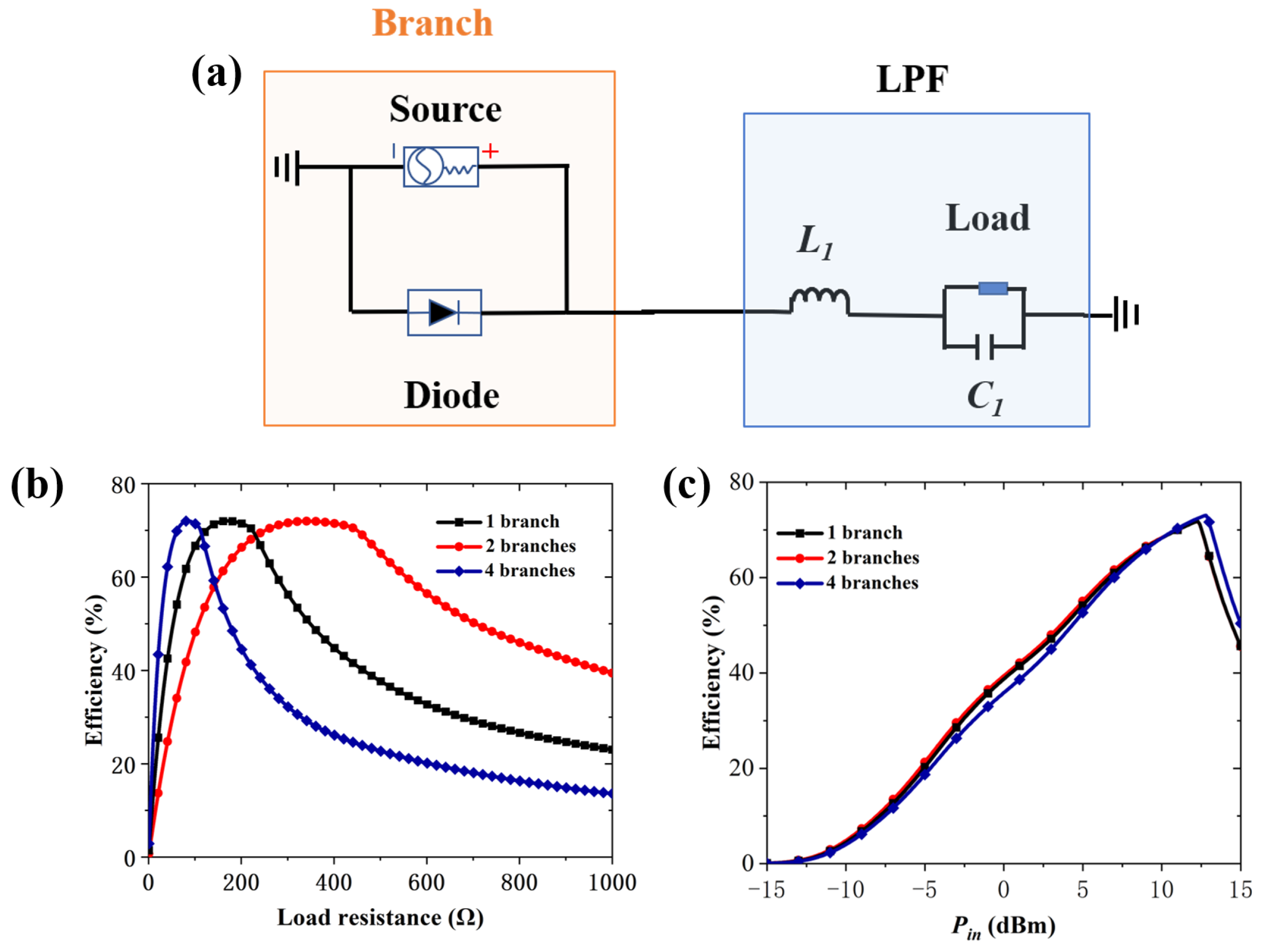


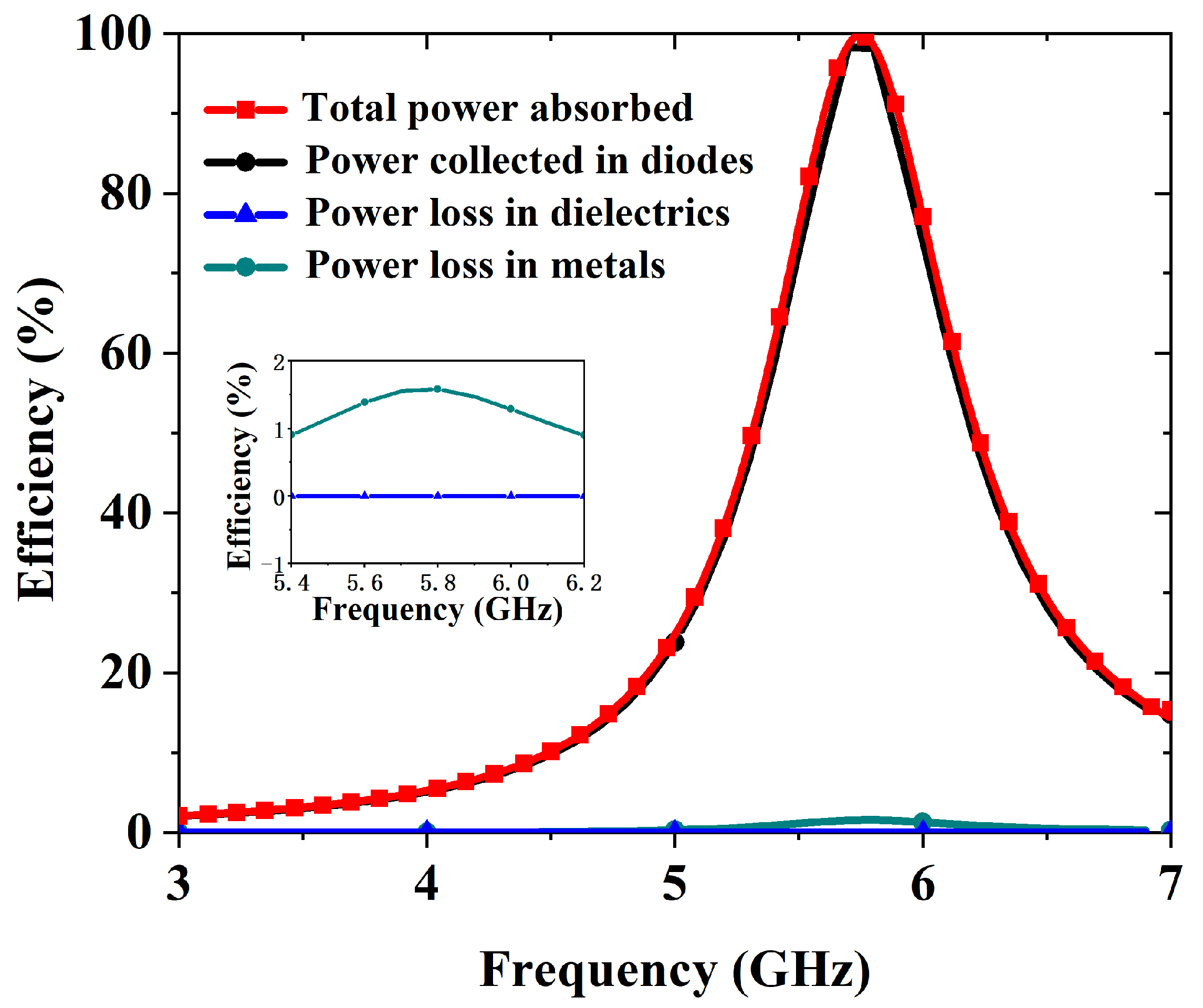
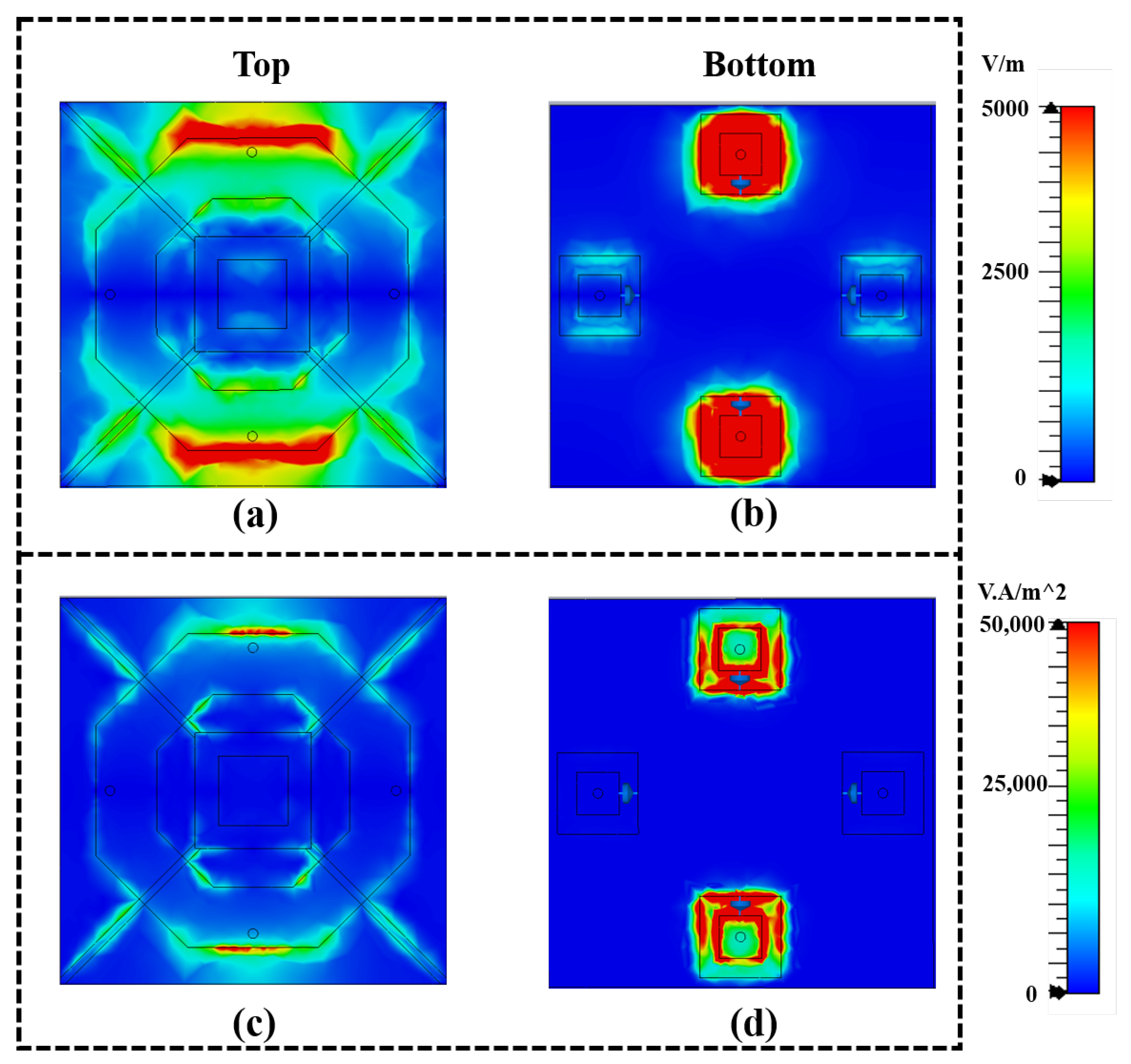
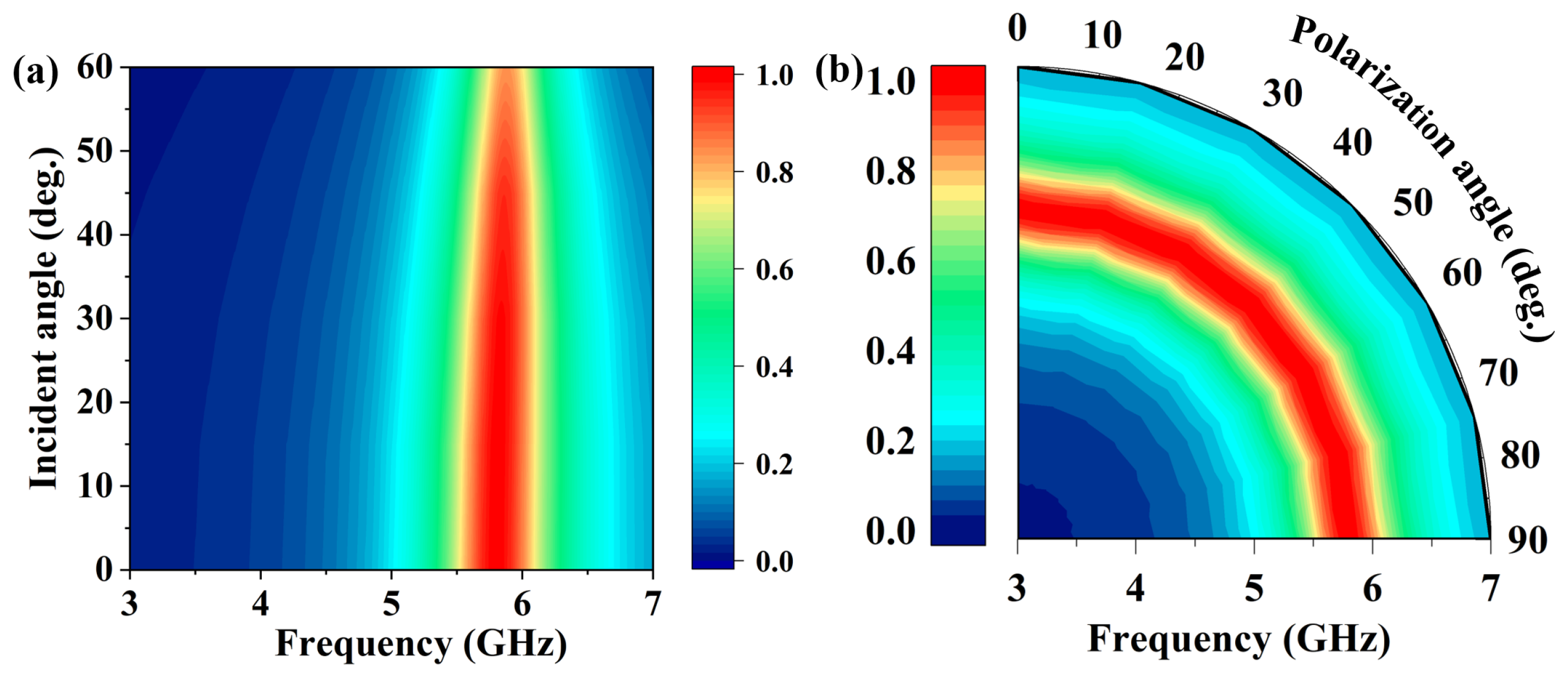
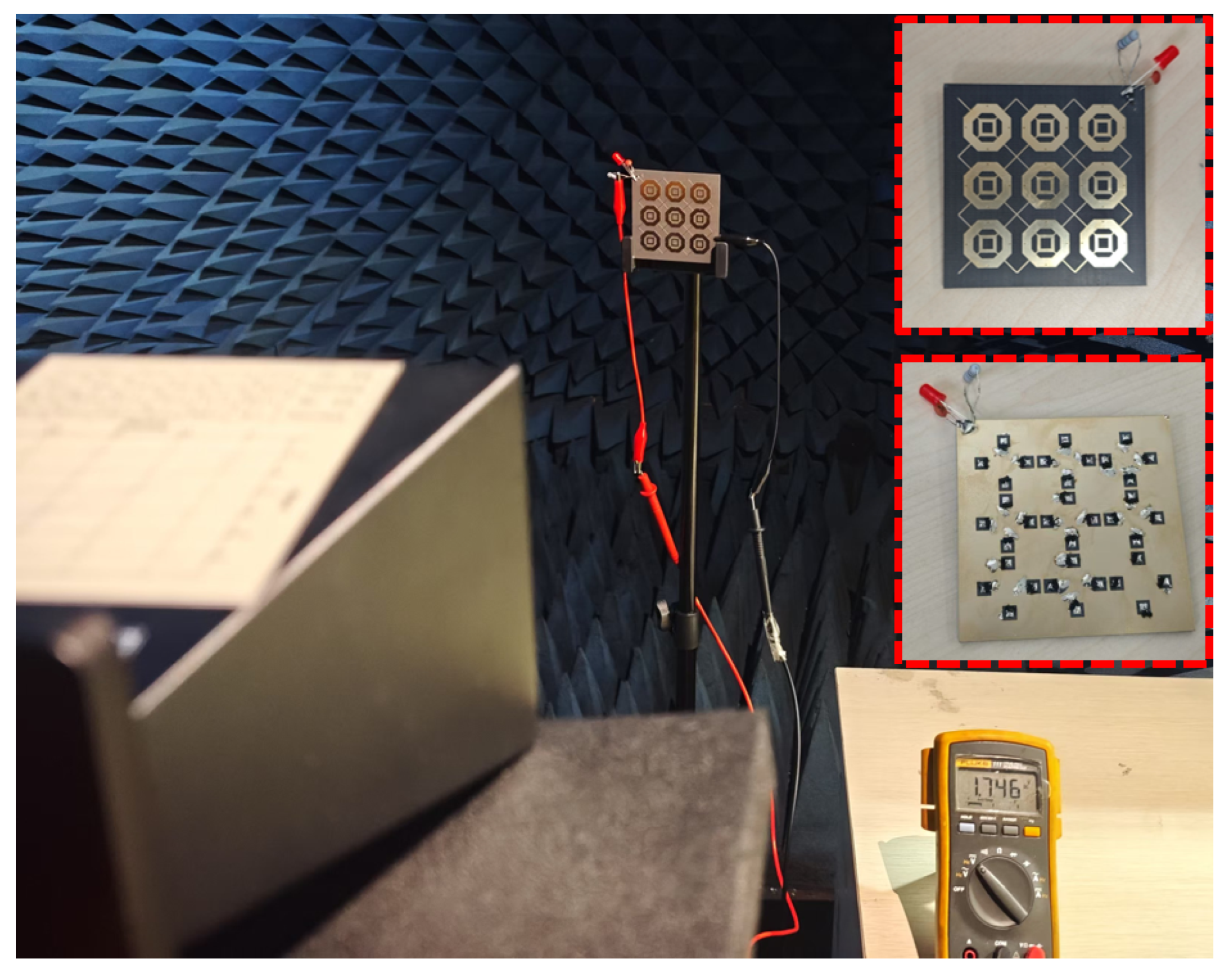
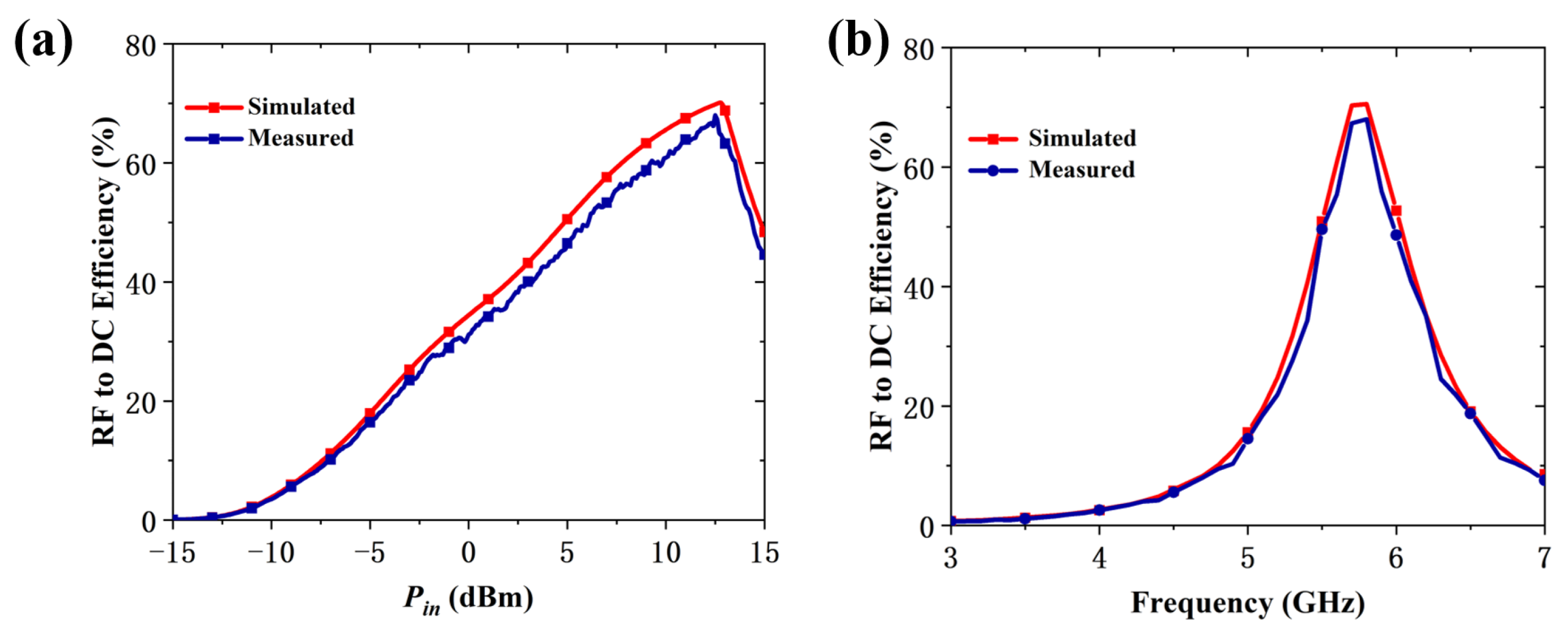
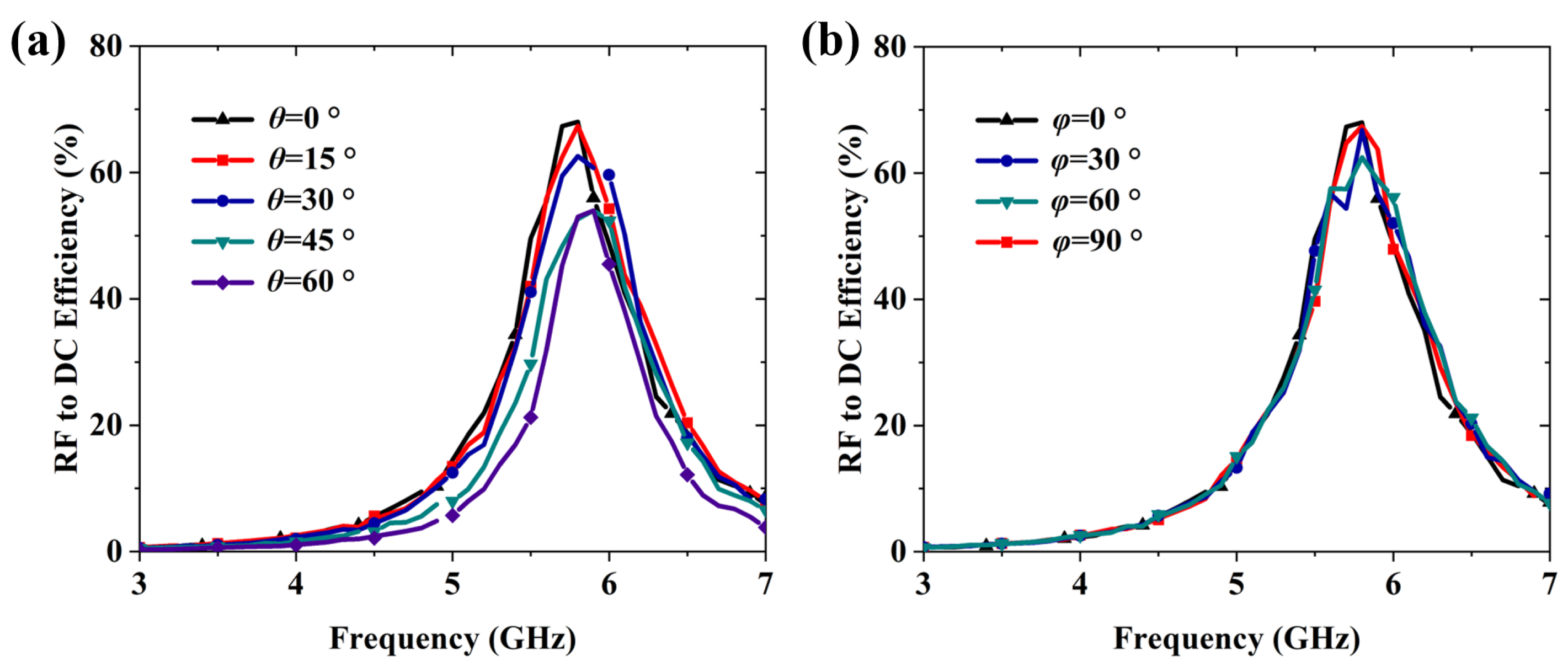
| Ref. | Frequency (GHz) | Polarization Insensitive | Optimal Power Level | Need Matching Network | RF to DC Efficiency |
|---|---|---|---|---|---|
| [33] | 2.4, 5.2, 5.8 | No | 7 dBm | Yes | 46.4% (5.8 GHz) |
| [35] | 5.8 | No | 7 dBm | Yes | 72% |
| [36] | 5.3–6.6 | No | 5 dBm | Yes | 57% |
| [37] | 5.8 | Yes | 350 mw/ | Yes | 55% |
| [38] | 2.4, 5.8 | Yes | 10 dBm | No | 59.0% (5.8 GHz) |
| This Work | 5.8 | Yes | 12.5 dBm | No | 68.3% |
Disclaimer/Publisher’s Note: The statements, opinions and data contained in all publications are solely those of the individual author(s) and contributor(s) and not of MDPI and/or the editor(s). MDPI and/or the editor(s) disclaim responsibility for any injury to people or property resulting from any ideas, methods, instructions or products referred to in the content. |
© 2025 by the authors. Licensee MDPI, Basel, Switzerland. This article is an open access article distributed under the terms and conditions of the Creative Commons Attribution (CC BY) license (https://creativecommons.org/licenses/by/4.0/).
Share and Cite
Guo, Z.; Yu, J.; Dong, L. A Wide-Angle and Polarization-Insensitive Rectifying Metasurface for 5.8 GHz RF Energy Harvesting. Micromachines 2025, 16, 611. https://doi.org/10.3390/mi16060611
Guo Z, Yu J, Dong L. A Wide-Angle and Polarization-Insensitive Rectifying Metasurface for 5.8 GHz RF Energy Harvesting. Micromachines. 2025; 16(6):611. https://doi.org/10.3390/mi16060611
Chicago/Turabian StyleGuo, Zhihui, Juan Yu, and Lin Dong. 2025. "A Wide-Angle and Polarization-Insensitive Rectifying Metasurface for 5.8 GHz RF Energy Harvesting" Micromachines 16, no. 6: 611. https://doi.org/10.3390/mi16060611
APA StyleGuo, Z., Yu, J., & Dong, L. (2025). A Wide-Angle and Polarization-Insensitive Rectifying Metasurface for 5.8 GHz RF Energy Harvesting. Micromachines, 16(6), 611. https://doi.org/10.3390/mi16060611





